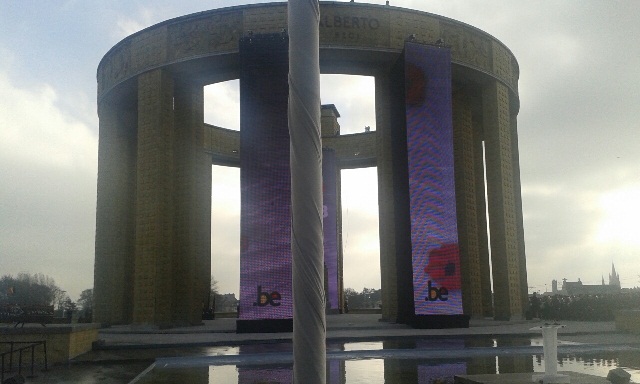|
Why, Now, the First World War? (No.5)
1st December 2014

About a month ago, on 28 November, I attended the World War I centennial commemoration event, hosted by the Belgian government, at Nieuwpoort and Ypres. This time, I would like to tell you more about my impressions.
When speaking of commemorative events in Japan, the 70th anniversary of the end of World War II comes to mind, which is in 2015. In Europe, on the other hand, when speaking of commemorative events, it is, of course, the 100th anniversary of World War I and also the 25th anniversary of the fall of the Berlin wall.
The First World War was triggered by the assassination of the Austrian Crown Prince on 28 June 1914. On 28 July of the same year, Austria-Hungary declared war on Serbia and the Great War broke out. Until the armistice was signed on 11 November 1918, the war that lasted nearly four years and four months had taken just shy of 10 million lives or 17,5 million, when including missing soldiers. An innumerable number of people fell victim to the war.
As a matter of fact, Belgium was one of the main battlefields of the First World War. There were several battlefields to be precise, but essentially, the battle seesawed and the front lines where the most vicious battles took place remained unchanged for over four years. For the most part, it traversed the north of Belgium longitudinally, tracing the north-east of France and even went as far as the Swiss northwestern borders. To put it the other way around, hardly any fighting took place in Germany and most of the soldiers killed in action from Britain and other commonwealth countries lost their lives in the aforementioned areas.
 Several commemoration ceremonies are planned from this year on until the 100th anniversary of Armistice in 2018. The memorial ceremony to commemorate the outbreak of the war in Belgium, which was on the 4th of August 1914, was held in Liège last August 4. The ceremony that was held on October 28 was meant to commemorate the 100th anniversary of the ‘First Battle of Ypres’ (19 October – 22 November 1914).
Several commemoration ceremonies are planned from this year on until the 100th anniversary of Armistice in 2018. The memorial ceremony to commemorate the outbreak of the war in Belgium, which was on the 4th of August 1914, was held in Liège last August 4. The ceremony that was held on October 28 was meant to commemorate the 100th anniversary of the ‘First Battle of Ypres’ (19 October – 22 November 1914).
Ypres, located in the northwest of Belgium and considered a strategic spot, is an area that was subject to several battles throughout the First World War and where a great number of lives were lost. This region is called the Yser-plain; because of its flat terrain and its low level above the sea, the Belgian government deliberately breached the dikes and strategically flooded the area. The consequences of the flood were so big they altered the landscape entirely. Furthermore, as trench warfare was the primary form of fighting, with winter approaching, the soldiers on both sides found themselves in an unimaginably abysmal environment. With this in mind, at the ceremony a man-made pool was created in front of the memorial, where a performance was held.
Ypres is also known for being the first place in human history where, in World War I, chemical weapons were used on a large scale. This was during the Second Battle of Ypres that took place from 22 April to 25 May 1915. Mustard gas, one of these chemical weapons, and also known as Yperite, owes its name to this fact.
Well then, you might ask yourself why I, as Ambassador of Japan, was invited to the 100th anniversary of World War I. That is, as you may already know, because Japan was a member of the allied forces during World War I. However, as a result of this, 80 precious lives of the Japanese Imperial Navy were lost on European front lines in the Mediterranean Sea. Even among Japanese, I think this is a little known fact.
At that time, Japan entered the war upon British request, based on the Anglo-Japanese Alliance and captured the German-leased Qingdao and Jiaozhou. Furthermore, Japan occupied some of the South Sea Islands that were under German colonization. On the other hand, Japan had repeatedly denied the request from Britain and other countries to dispatch Japanese troops to Europe and also kept refusing requests to involve the Navy. However, in 1917, in order to protect allied transportation activities in the Indian Sea and the Mediterranean Sea, Japan eventually decided to send out a special task fleet. Their assignment in the Mediterranean Sea was to escort the ‘Great Transportation Mission’ that carried allied troops from Alexandria to Marseille. Unfortunately, on that occasion, the Japanese destroyer Sakaki got attacked by a submarine from the Austro-Hungarian Empire and was severely damaged, resulting into the loss of 59 lives. When taking other battles into consideration, the number of Japanese soldiers that perished in battle in the Mediterranean Sea amounts to 78 casualties. Japan has truly fought alongside Europe, in Europe.
I am told that, the Japanese casualties are enshrined in a tombstone in a corner of a British Commonwealth cemetery built after the war. I would very much like to visit this place if the opportunity presents itself.(*)
(*) This is a citation from the Wikipedia article ‘Japan in World War I’.
|
